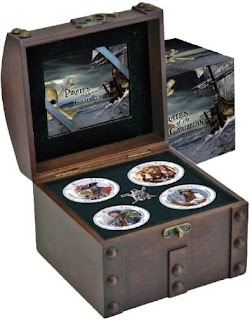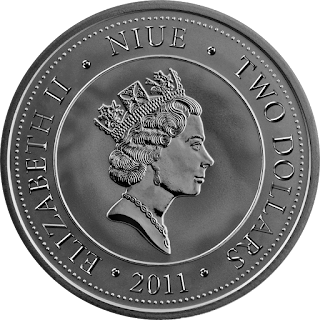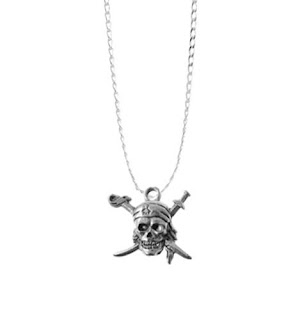Niue 2 Dollars 2011 Real Pirates of the Caribbean 4 Coin Proof Set
The Real Pirates of the Caribbean - New Zealand Mint’s latest commemorative coin set release.
The New Zealand Mint has created another masterful 1 oz. Silver Coin Set with the release of the 2011 Real Pirates of the Caribbean Four Coin - Treasure Chest Box Set.This highly collectible coin set features Blackbeard, Calico Jack, Bartholomew Roberts, and Henry Avery – the most infamous pirates to roam the high seas. Each pirate’s image is colourfully depicted in exquisite detail on the back of each coin.
Replica Wooden Pirate’s Chest Display Case - The four coin Real Pirates of the Caribbean set is displayed in a replica wooden pirate’s chest. Each set includes a skull and crossbones pendant necklace and a certificate of authenticity with a background on each famous pirate.
The great or classic era of piracy in the Caribbean extends from around 1560 up until the mid 1720s. The period during which pirates were most successful was from 1700 until the 1730s. Caribbean piracy arose out of, and mirrored on a smaller scale, the conflicts over trade and colonization among the rival European powers of the time, including the empires of Britain, Spain, the Netherlands, Portugal and France. Most of these pirates were of English, Dutch and French origin. Because Spain controlled most of the Caribbean, many of the attacked cities and ships belonged to the Spanish Empire and along the East coast of America and the West coast of Africa. Dutch ships captured about 500 Spanish and Portuguese ships between 1623 and 1638. Some of the best-known pirate bases were New Providence, in the Bahamas from 1715 to 1725, Tortuga established in the 1640s and Port Royal after 1655.
The reverse of the coins features a full coloured image of the most famous Caribbean pirates; Edward Teach or Blackbeard, Calico Jack Rackham, Henry Every and the most successful Bartholomew Roberts.
The obverse of the coin features The Raphael Maklouf effigy of Her Majesty the Queen Elizabeth II sovereign of the commonwealth of Niue.
Each coin in the Pirates of the Caribbean set is struck from 1oz of pure silver. No more than 8,000 coins will be issued by the New Zealand Mint. The coins are legal tender of Niue Island.
Minting Specifications:
Metal: 999 Silver / Coloured.
Finish: Proof.
Weight: 1 troy oz.
Diameter: 40 mm.
Edge: Milled.
Denomination: $2.
Country of Issue: Niue.
Year of Issue: 2011.
Mintage: 8,000 sets.
Roberts took to piracy late, after the age of 37, but he quickly rose to captaincy. He even designed a flag for himself, portraying a giant figure of himself standing, sword in hand, astride two skulls labelled A.B.H. (“a Barbadian’s head”) and A.M.H. (“a Martinican’s head”). He was finally felled by grapeshot in battle with a pursuing British warship off the Guinea coast of Africa.
Blackbeard, byname of Edward Teach, Teach also spelled Thatch or Thack (born c. 1680, Bristol, England — died November 22, 1718, Ocracoke Island, North Carolina [U.S.]), was a notorious English pirate who operated around the West Indies and the eastern coast of the American colonies, one of history’s most famous pirates, who became an imposing figure in American folklore. Little is known of Blackbeard’s early life, and his origins have been left to speculation. He has been widely identified as Edward Teach (or several variations thereof, including Thatch and Thack), though pirate custom at the time was to use a pseudonym when engaging in acts of piracy, and his true name will probably never be known. Although little is known about his early life, he was probably born in Bristol, England. He may have been a sailor on privateer ships during Queen Anne's War before settling on the Bahamian island of New Providence, a base for Captain Benjamin Hornigold, whose crew Teach joined sometime around 1716. Hornigold placed him in command of a sloop he had captured, and the two engaged in numerous acts of piracy. Their numbers were boosted by the addition to their fleet of two more ships, one of which was commanded by Stede Bonnet, but toward the end of 1717 Hornigold retired from piracy, taking two vessels with him.
Teach captured a French merchant vessel, renamed her Queen Anne's Revenge, and equipped her with 40 guns. He became a renowned pirate, his cognomen derived from his thick black beard and fearsome appearance; he was reported to have tied lit fuses under his hat to frighten his enemies. He formed an alliance of pirates and blockaded the port of Charleston, South Carolina. After successfully ransoming its inhabitants, he ran Queen Anne's Revenge aground on a sandbar near Beaufort, North Carolina. He parted company with Bonnet and settled in Bath Town, where he accepted a royal pardon. But he was soon back at sea, where he attracted the attention of Alexander Spotswood, the Governor of Virginia. Spotswood arranged for a party of soldiers and sailors to try to capture the pirate, which they did on 22 November 1718. During a ferocious battle, Teach and several of his crew were killed by a small force of sailors led by Lieutenant Robert Maynard. The pirate’s body was decapitated, and his head was affixed to the end of the bowsprit of his ship.
A shrewd and calculating leader, Teach spurned the use of force, relying instead on his fearsome image to elicit the response he desired from those he robbed. Contrary to the modern-day picture of the traditional tyrannical pirate, he commanded his vessels with the permission of their crews and there is no known account of his ever having harmed or murdered those he held captive. He was romanticised after his death and became the inspiration for pirate-themed works of fiction across a range of genres.
Apart from the luxuriant black beard which earned him his nickname, the most prominent aspect of the Blackbeard legend is his great buried treasure, which has never been found and probably never existed. The wreck of the Queen Anne’s Revenge, however, was discovered off the coast of North Carolina by divers in the mid-1990s. Hundreds of artifacts were recovered from the site in the following decades, including navigational devices, cannons, and a sword hilt.
Henry Every, also Evory or Avery, (23 August 1659 – after 1696), sometimes erroneously given as John Avery, was an English pirate who operated in the Atlantic and Indian oceans in the mid-1690s. He probably used several aliases throughout his career, including Benjamin Bridgeman, and was known as Long Ben to his crewmen and associates.
Dubbed "The Arch Pirate" and "The King of Pirates" by contemporaries, Every was the most notorious pirate of his time; he earned his infamy by becoming one of the few major pirate captains to retire with his loot without being arrested or killed in battle, and also for being the perpetrator of what has been called the most profitable pirate raid in history. Although Every's career as a pirate lasted only two years, his exploits captured the public's imagination, inspired others to take up piracy, and spawned numerous works of literature.
Every was born in England's West Country, but little else is known about his early life. He served in the Royal Navy from 1689 to 1690, likely participating in several battles of the Nine Years' War (1688–1697). Following his discharge from the navy, Every began slave trading along Africa's Slave Coast. In 1693, he was again employed as a mariner, this time as first mate aboard the warship Charles II, which had been commissioned by England's ally, Charles II of Spain (the ship's namesake), to prey on French vessels in the West Indies. After leaving London in August 1693, the Charles II anchored in the northern Spanish harbor of Corunna, where other vessels were assembling for the expedition. The crew grew discontent as Madrid failed to deliver a letter of marque and the Charles II's owners failed to pay their wages. On the evening of 7 May 1694, the restless sailors mutinied. With the Charles II renamed the Fancy and Every elected as the new captain, the Fancy sailed south en route to the Indian Ocean, soon plundering five ships off the West African coast.
In early 1695 the Fancy had reached the Comoros Islands, where Every's crew raided a French vessel and narrowly escaped capture by three East Indiamen. The Fancy then sailed north to the Arabian Sea, where a 25-ship convoy of Grand Mughal vessels was making the annual pilgrimage to Mecca, including the treasure-laden flagship Ganj-i-sawai and its escort, the Fateh Muhammed. Joining forces with several pirate vessels, Every found himself in command of a small pirate squadron, including a sloop captained by English pirate Thomas Tew. As the pirates gave chase, the smaller vessels in the squadron gradually fell behind, and at some point Tew was killed in an engagement with a Mughal ship. Every had more success, however, capturing the Fateh Muhammed and later overtaking the Ganj-i-sawai, snapping its mainmast in a cannonball volley. Following several hours of ferocious hand-to-hand combat on deck, the pirates emerged victorious. Although many pirates were reportedly killed, the payoff was astonishing: Every had captured up to £600,000 in precious metals and jewels, making him the richest pirate in the world, equivalent to around £52.4m in 2010. Of note is that after this raid, Avery and his crew tortured and killed a great number of the passengers and raped women of all ages. Some women stabbed themselves with daggers or jumped overboard, committing suicide to escape this fate.
The plunder of Ganj-i-sawai caused considerable damage to England's fragile relations with the Mughals. In response to Every's attack, a combined bounty of £1000 — an immense sum by the standards of the time — was offered for his capture by the Privy Council and the East India Company, leading to the first worldwide manhunt in recorded history. Every and his crew fled to the Bahamas, briefly sheltering in New Providence, a known pirate haven. After adopting aliases, the crew broke company, most choosing to sail home to the British Isles and the rest remaining in the British West Indies or taking to the North American colonies. Twenty-four of the pirates were eventually captured, and six were tried, convicted, and hanged in London in November 1696. Yet Every eluded capture, vanishing from all records in 1696; his whereabouts and activities after this period are unknown. Unconfirmed accounts state he may have changed his name and retired, quietly living out the rest of his life in either Britain or an unidentified tropical island, dying sometime after 1696. Colin Woodard states that Avery, in trying to launder his riches to currency, had been outsmarted by wealthy landowners and died a poor beggar not being able to afford his own coffin.
John Rackham (26 December 1682 – 18 November 1720), commonly known as Calico Jack, was an English pirate captain operating in the Bahamas and in Cuba during the early 18th century. (Rackham is often spelled as Rackam or Rackum in historical documentation, and he is also often referred to as Jack Rackham.) His nickname was derived from the calico clothing that he wore, while Jack is a nickname for "John."
Rackham was active towards the end (1718–1720) of the "Golden Age of Piracy" which lasted 1650 to 1730. He is most remembered for two things: the design of his Jolly Roger flag, a skull with crossed swords, which contributed to the popularization of the design, and for having two female crew members: Mary Read and his lover Anne Bonny.
Rackham deposed Charles Vane from his position as captain of the sloop Ranger, then cruised the Leeward Islands, Jamaica Channel, and Windward Passage. He accepted a pardon some time in 1719 and moved to New Providence, where he met Anne Bonny, who was married to James Bonny at the time. He returned to piracy in 1720 by stealing a British sloop, and Anne joined him. Their new crew included Mary Read, who was disguised as a man at the time. After a short run, Rackham was captured by pirate hunter Jonathan Barnet in 1720, and was hanged in November of that year in Port Royal, Jamaica.
Crossbones pendant necklace







